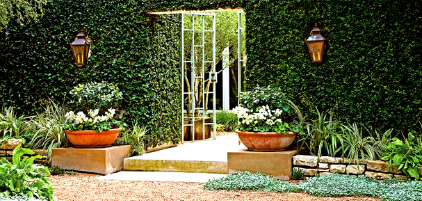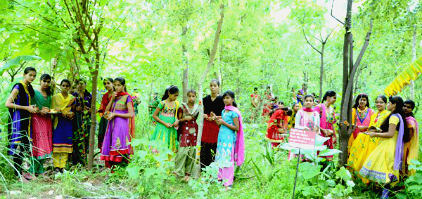
bringing nature, nurseries and gardeners together Sept 13 2018
Nursery notes: at Brite Ideas on Saturday at noon you can learn
all about Microgreens and Sprouting from Jason Avent (4201
South Congress, Suite 310.) / At The Natural Gardener on Saturday
at 10 a.m. there's a Brew your own Kombucha class; and on Tues-
day at 10 a.m. learn all about Infused Liquor and Shrub Making
from Neil Schmidt. (A shrub is a colonial-era mixture of herbs,
fruit and vinegar.) On sale, 20% off rain chains and wind chimes./
Barton Springs Nursery has a fine selection of host plants for butter-
flies, including Prairie redroot, Dutchman's Pipe, blue boneset and
pyramid bush, and some 1 gal. native trees.❦
all about Microgreens and Sprouting from Jason Avent (4201
South Congress, Suite 310.) / At The Natural Gardener on Saturday
at 10 a.m. there's a Brew your own Kombucha class; and on Tues-
day at 10 a.m. learn all about Infused Liquor and Shrub Making
from Neil Schmidt. (A shrub is a colonial-era mixture of herbs,
fruit and vinegar.) On sale, 20% off rain chains and wind chimes./
Barton Springs Nursery has a fine selection of host plants for butter-
flies, including Prairie redroot, Dutchman's Pipe, blue boneset and
pyramid bush, and some 1 gal. native trees.❦

Austin garden focus: the heat-tolerant garden of a Tarrytown
couple appeared in Southern Living recently. 'Visiting here means
experiencing a series of lush, welcoming, and neat-as-a-pin garden
rooms,' writes Steve Bender. Working on the project were designers

Tree folks: every time a little girl is born in the Indian town of
Piplantri in Rajasthan, the village plants 111 trees to honor her
birth. The parents and the villagers also pool money to create a
fund to give to the daughter when she is 18 and has graduated
from a high school. Green Planet ❦
____________________________________________________
Updates on 'the Thyme Team': last Wednesday Russ joined an
exciting new venture called Wimberley Gardens (419 FM 2325,
78676). This young nursery has native perennials, annuals, organic
soils, compost, house plants, pottery, candles and unique gifts and
is well worth a visit if you're in the Wimberley area. / Jerry has
joined Far South Wholesale Nursery. ❦

Corn and lavender paletas: these Mexican style popsicles are
easy to make and fun to eat. Combine 4 ears of corn, coconut milk,
sugar, lavender and vanilla - and pour into a popsicle mold. Thanks
to Stephanie Cameron for sharing this. Edible New Mexico ❦
____________________________________________________
The Austin Garden is sponsored by the.Hays Free Press

___________________________________________________
Central Texas Gardener: in the studio, a discussion about
succulents with folks from Deserts to Tropics nursery; on tour,
a visit with graphics designer James Barela of Baetanical. See
the show on Saturday 4 p.m., Sunday 9 a.m. KLRU ❦

At Keukenhof in Holland, gardeners plant over 7 million bulbs each year. (photo:wiki)
10 Bulb Favorites for Central Texas
by Amanda Moon
If you love flower bulbs, now is the time to plan and plant for the
spring of 2019. Although we will never be able to create the rolling
fields of hyacinths and tulips like the Dutch, there are still many
wonderful bulbs that thrive in our mild winters and hot summers,
and return bigger and better every year.
Many gardeners like to add them to their existing beds as seasonal
spot color, since most of them bloom for just a short period and
then enter dormancy until the following year.
The ten bulbs listed below are easy to care for. Generally, southern
bulbs flourish in any well-drained soil. You can water them a little
to help them bloom the best, but drought will usually not kill them.
Some just wait patiently until the first good rain and then shoot up
a bloom stalk within days. After blooming, allow the leaves to die
back naturally and leave them alone: they are storing up energy for
next year.
1. Daffodils/Narcissus: Many of the hybrids, such as the pink
or double varieties, will return to bloom for a few years. The heir-
looms – standard yellows and paperwhites – will blossom for many
years with little assistance.
____________________________________________________
2. Bearded Iris: Although a rhizome and not a true bulb, you
can’t get a better performer for central Texas gardens. They're mostly
evergreen and I have yet to find one that doesn’t love our climate,
whether the old-fashioned purple and whites or the fancier hybrids.
Irises are highly fragrant when they bloom and are beautiful as cut
flowers. Plant leaving half the rhizome exposed and with enough
sun to ensure blooms.
____________________________________________________
3. Peruvian Daffodil, Spider Flower: These bulbs grow
into large stands of white flowers atop long, strapping foliage and
can be striking accent plants as well as a small 'hedge' if happy
enough. Their downfall (like many bulbs) is too much water, so
make sure they are not planted in a low-lying area as some of our
years are quite wet.
____________________________________________________
4. Amaryllis: These traditional Christmas flowers are actually
warm season bulbs that are bought during the holidays to enjoy,
but then can be planted outside in the spring. Amaryllis are trad-
itionally forced (tricked into blooming outside of their natural
bloom cycle) so that they flower in winter even though they norm-
ally bloom in the spring and summer in Texas. Pot them into a con-
tainer and then transplant them to a morning sun bed in the spring.
____________________________________________________
5. Spider Lilies: (aka Hurricane or Schoolhouse lilies) They
bloom after heavy rains in late summer or early fall and go dor-
mant until the next summer. The foliage is an attractive green with
a pale green central stripe. Lycoris is easy to grow and a great heir-
loom bulb. (see photo above)
____________________________________________________
6. Crinums: These lilies are an old plant that many of our grand-
parents had in their gardens. The flowers are a starry bell shape and
come in hues of pink and white and some are even striped. Crinums
need a sunny spot to bloom and many can get quite large . . . so
give them plenty of space!
____________________________________________________
7. Muscari (grape hyacinth): These smaller plants make good
filler and bloom in the very early spring. I have some growing
under the water faucet in the flowerbed for a beautiful punch of
color every spring.
____________________________________________________
8. Lily of the Valley, Snowflake Leucojum aestivum: These
old-fashioned bulbs should be grown more. They are the first to
bloom in the spring (late winter for us) and the white/green flowers
last for some time. They can be grown in shade or sun and are very
tolerant of a wide variety of soil types and moisture levels. Note:
There is a larger-leaved bulbous plant also called Lily of the Valley
that struggles here, so make sure the genus (Leucojum) is correct
when buying.
____________________________________________________
9. Oxblood Lilies Rhodophiala bifida: An heirloom flower
found in many old cemeteries and homesteads. The red flowers
appear on naked stalks in September or October depending on
rainfall. Although the flowers are fairly short lived they look
stunning when you see them blooming under an oak tree en masse.
Shade and neglect are not a problem for these hardy bulbs; in fact
they thrive under these conditions.
____________________________________________________
10. Species Tulips: Although hybrid (florist-type) tulips are short
lived here in Texas, we can do quite well with species tulips.
They are more natural-looking and a little looser in form, but will
bloom for many years in the right spot. I have mine mixed in with
pots of spider lilies and amaryllis and they are quite happy.
Happy gardening everyone! ❦

